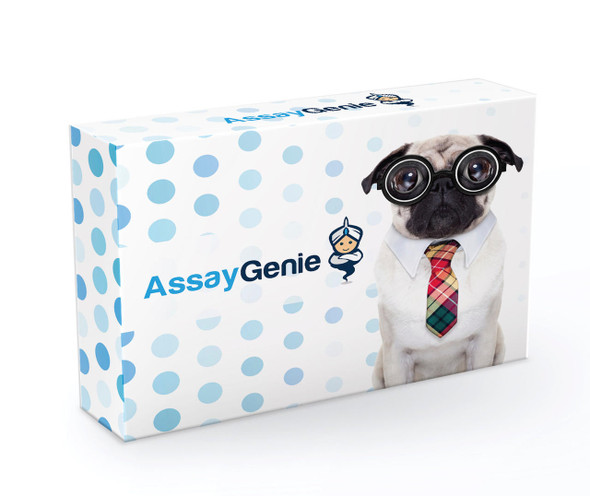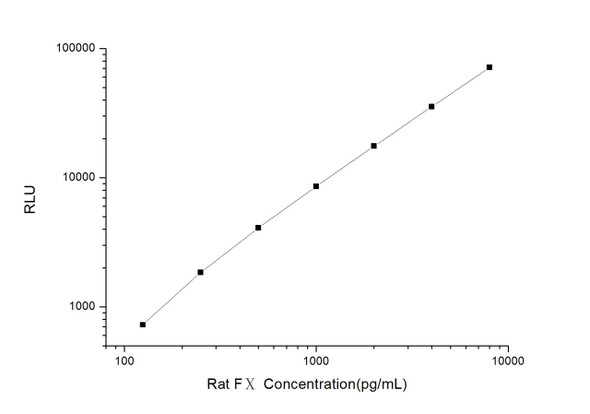Rat Signaling ELISA Kits 2
Rat F2(Coagulation Factor 2)CLIA Kit (RTES00128)
- SKU:
- RTES00128
- Product Type:
- ELISA Kit
- ELISA Type:
- CLIA Kit
- Size:
- 96 Assays
- Sensitivity:
- 18.75pg/mL
- Range:
- 31.25-2000pg/mL
- ELISA Type:
- Sandwich
- Reactivity:
- Rat
- Sample Type:
- Serum, plasma and other biological fluids
- Research Area:
- Immunology
Description
| Assay type: | Sandwich |
| Format: | 96T |
| Assay time: | 4.5h |
| Reactivity: | Rat |
| Detection method: | Chemiluminescence |
| Detection range: | 31.25-2000 pg/mL |
| Sensitivity: | 18.75 pg/mL |
| Sample volume: | 100µL |
| Sample type: | Serum, plasma and other biological fluids |
| Repeatability: | CV < 15% |
| Specificity: | This kit recognizes Rat F2 in samples. No significant cross-reactivity or interference between Rat F2 and analogues was observed. |
This kit uses Sandwich-CLIA as the method. The micro CLIA plate provided in this kit has been pre-coated with an antibody specific to Rat F2. Standards or samples are added to the appropriate micro CLIA plate wells and combined with the specific antibody. Then a biotinylated detection antibody specific for Rat F2 and Avidin-Horseradish Peroxidase (HRP) conjugate are added to each micro plate well successively and incubated. Free components are washed away. The substrate solution is added to each well. Only those wells that contain Rat F2, biotinylated detection antibody and Avidin-HRP conjugate will appear fluorescence. The Relative light unit (RLU) value is measured spectrophotometrically by the Chemiluminescence immunoassay analyzer. The RLU value is positively associated with the concentration of Rat F2. The concentration of Rat F2 in the samples can be calculated by comparing the RLU of the samples to the standard curve.
| UniProt Protein Function: | prothrombin: Thrombin, which cleaves bonds after Arg and Lys, converts fibrinogen to fibrin and activates factors V, VII, VIII, XIII, and, in complex with thrombomodulin, protein C. Functions in blood homeostasis, inflammation and wound healing. Defects in F2 are the cause of factor II deficiency (FA2D). It is a very rare blood coagulation disorder characterized by mucocutaneous bleeding symptoms. The severity of the bleeding manifestations correlates with blood factor II levels. Genetic variations in F2 may be a cause of susceptibility to ischemic stroke (ISCHSTR); also known as cerebrovascular accident or cerebral infarction. A stroke is an acute neurologic event leading to death of neural tissue of the brain and resulting in loss of motor, sensory and/or cognitive function. Ischemic strokes, resulting from vascular occlusion, is considered to be a highly complex disease consisting of a group of heterogeneous disorders with multiple genetic and environmental risk factors. Defects in F2 are the cause of thrombophilia due to thrombin defect (THPH1). It is a multifactorial disorder of hemostasis characterized by abnormal platelet aggregation in response to various agents and recurrent thrombi formation. A common genetic variation in the 3-prime untranslated region of the prothrombin gene is associated with elevated plasma prothrombin levels and an increased risk of venous thrombosis. Defects in F2 are associated with susceptibility to pregnancy loss, recurrent, type 2 (RPRGL2). A common complication of pregnancy, resulting in spontaneous abortion before the fetus has reached viability. The term includes all miscarriages from the time of conception until 24 weeks of gestation. Recurrent pregnancy loss is defined as 3 or more consecutive spontaneous abortions. Belongs to the peptidase S1 family. |
| UniProt Protein Details: | Protein type:Secreted, signal peptide; EC 3. 4. 21. 5; Protease; Apoptosis; Secreted Cellular Component: extracellular matrix; extracellular space Molecular Function:peptidase activity; serine-type endopeptidase activity; calcium ion binding; receptor binding Biological Process: negative regulation of proteolysis; response to inactivity; platelet activation; positive regulation of blood coagulation; cytosolic calcium ion homeostasis; wound healing; positive regulation of collagen biosynthetic process; proteolysis; positive regulation of cell growth; positive regulation of phosphoinositide 3-kinase cascade; regulation of cell shape; fibrinolysis; cell surface receptor linked signal transduction; regulation of gene expression; positive regulation of cell proliferation; negative regulation of astrocyte differentiation; response to wounding; acute-phase response; positive regulation of release of sequestered calcium ion into cytosol; positive regulation of protein amino acid phosphorylation; blood coagulation |
| NCBI Summary: | catalyzes the preferential cleavage of Arg-Gly; activates fibrinogen to fibrin and releases fibrinopeptides A and B; involved in blood coagulation and wound repair [RGD, Feb 2006] |
| UniProt Code: | P18292 |
| NCBI GenInfo Identifier: | 135809 |
| NCBI Gene ID: | 29251 |
| NCBI Accession: | P18292. 1 |
| UniProt Related Accession: | P18292 |
| Molecular Weight: | 72,000 |
| NCBI Full Name: | Prothrombin |
| NCBI Synonym Full Names: | coagulation factor II |
| NCBI Official Symbol: | F2 |
| NCBI Protein Information: | prothrombin; coagulation factor 2 |
| UniProt Protein Name: | Prothrombin |
| UniProt Synonym Protein Names: | Coagulation factor II |
| Protein Family: | Prothrombin |
| UniProt Gene Name: | F2 |
| UniProt Entry Name: | THRB_RAT |
As the RLU values of the standard curve may vary according to the conditions of the actual assay performance (e. g. operator, pipetting technique, washing technique or temperature effects), the operator should establish a standard curve for each test. Typical standard curve and data is provided below for reference only.
| Concentration (pg/mL) | RLU | Average | Corrected |
| 2000 | 50825 60617 | 55721 | 55693 |
| 1000 | 23662 24286 | 23974 | 23946 |
| 500 | 11144 10920 | 11032 | 11004 |
| 250 | 5293 5295 | 5294 | 5266 |
| 125 | 2764 2452 | 2608 | 2580 |
| 62.5 | 1388 1234 | 1311 | 1283 |
| 31.25 | 640 708 | 674 | 646 |
| 0 | 27 29 | 28 | -- |
Precision
Intra-assay Precision (Precision within an assay): 3 samples with low, mid range and high level Rat F2 were tested 20 times on one plate, respectively.
Inter-assay Precision (Precision between assays): 3 samples with low, mid range and high level Rat F2 were tested on 3 different plates, 20 replicates in each plate.
| Intra-assay Precision | Inter-assay Precision | |||||
| Sample | 1 | 2 | 3 | 1 | 2 | 3 |
| n | 20 | 20 | 20 | 20 | 20 | 20 |
| Mean (pg/mL) | 103.17 | 317.78 | 775.85 | 94.18 | 299.37 | 812.57 |
| Standard deviation | 9.11 | 28.82 | 80.92 | 9.95 | 21.17 | 68.42 |
| C V (%) | 8.83 | 9.07 | 10.43 | 10.56 | 7.07 | 8.42 |
Recovery
The recovery of Rat F2 spiked at three different levels in samples throughout the range of the assay was evaluated in various matrices.
| Sample Type | Range (%) | Average Recovery (%) |
| Serum (n=5) | 94-110 | 100 |
| EDTA plasma (n=5) | 93-108 | 99 |
| Cell culture media (n=5) | 97-112 | 102 |
Linearity
Samples were spiked with high concentrations of Rat F2 and diluted with Reference Standard & Sample Diluent to produce samples with values within the range of the assay.
| Serum (n=5) | EDTA plasma (n=5) | Cell culture media (n=5) | ||
| 1:2 | Range (%) | 101-117 | 90-105 | 103-120 |
| Average (%) | 107 | 96 | 110 | |
| 1:4 | Range (%) | 91-105 | 93-105 | 97-110 |
| Average (%) | 97 | 98 | 104 | |
| 1:8 | Range (%) | 95-108 | 89-103 | 100-117 |
| Average (%) | 103 | 97 | 108 | |
| 1:16 | Range (%) | 99-114 | 96-114 | 97-107 |
| Average (%) | 106 | 104 | 102 |
An unopened kit can be stored at 4°C for 1 month. If the kit is not used within 1 month, store the items separately according to the following conditions once the kit is received.
| Item | Specifications | Storage |
| Micro CLIA Plate(Dismountable) | 8 wells ×12 strips | -20°C, 6 months |
| Reference Standard | 2 vials | |
| Concentrated Biotinylated Detection Ab (100×) | 1 vial, 120 µL | |
| Concentrated HRP Conjugate (100×) | 1 vial, 120 µL | -20°C(shading light), 6 months |
| Reference Standard & Sample Diluent | 1 vial, 20 mL | 4°C, 6 months |
| Biotinylated Detection Ab Diluent | 1 vial, 14 mL | |
| HRP Conjugate Diluent | 1 vial, 14 mL | |
| Concentrated Wash Buffer (25×) | 1 vial, 30 mL | |
| Substrate Reagent A | 1 vial, 5 mL | 4°C (shading light) |
| Substrate Reagent B | 1 vial, 5 mL | 4°C (shading light) |
| Plate Sealer | 5 pieces | |
| Product Description | 1 copy | |
| Certificate of Analysis | 1 copy |
- Set standard, test sample and control (zero) wells on the pre-coated plate and record theirpositions. It is recommended to measure each standard and sample in duplicate. Note: addall solutions to the bottom of the plate wells while avoiding contact with the well walls. Ensuresolutions do not foam when adding to the wells.
- Aliquot 100µl of standard solutions into the standard wells.
- Add 100µl of Sample / Standard dilution buffer into the control (zero) well.
- Add 100µl of properly diluted sample (serum, plasma, tissue homogenates and otherbiological fluids. ) into test sample wells.
- Cover the plate with the sealer provided in the kit and incubate for 90 min at 37°C.
- Aspirate the liquid from each well, do not wash. Immediately add 100µL of BiotinylatedDetection Ab working solution to each well. Cover the plate with a plate seal and gently mix. Incubate for 1 hour at 37°C.
- Aspirate or decant the solution from the plate and add 350µL of wash buffer to each welland incubate for 1-2 minutes at room temperature. Aspirate the solution from each well andclap the plate on absorbent filter paper to dry. Repeat this process 3 times. Note: a microplatewasher can be used in this step and other wash steps.
- Add 100µL of HRP Conjugate working solution to each well. Cover with a plate seal andincubate for 30 min at 37°C.
- Aspirate or decant the solution from each well. Repeat the wash process for five times asconducted in step 7.
- Add 100µL of Substrate mixture solution to each well. Cover with a new plate seal andincubate for no more than 5 min at 37°C. Protect the plate from light.
- Determine the RLU value of each well immediately.






